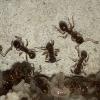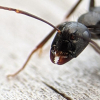Is Lasius aphidicola the same thing as Lasius aphidicolus?
- Formiculture.com
- Forums
- Gallery
- Members
- Member Map
- Chat

Is Lasius aphidicola the same thing as Lasius aphidicolus?
Currently keeping:
Tetramorium immigrans, Pogonomyrmex occidentalis
Myrmica punctiventris, Formica subsericea
Formica pallidefulva, Aphaeogaster cf. rudis
Camponotus pennsylvanicus
Camponotus nearcticus
Crematogaster cerasi
Temnothorax ambiguus
Prenolepis imparis
Has anyone kept this species long term?
Currently keeping:
Tetramorium immigrans, Pogonomyrmex occidentalis
Myrmica punctiventris, Formica subsericea
Formica pallidefulva, Aphaeogaster cf. rudis
Camponotus pennsylvanicus
Camponotus nearcticus
Crematogaster cerasi
Temnothorax ambiguus
Prenolepis imparis
Oh, this explains everything (aka one thing)! They prefer a dry nest, that's why they hang out away from the water.
Currently keeping:
Tetramorium immigrans, Pogonomyrmex occidentalis
Myrmica punctiventris, Formica subsericea
Formica pallidefulva, Aphaeogaster cf. rudis
Camponotus pennsylvanicus
Camponotus nearcticus
Crematogaster cerasi
Temnothorax ambiguus
Prenolepis imparis
My Main Journal | My Neivamyrmex Journal | My Ant Adoption | My YouTube
Join the TennesseeAnts Discord Server! https://discord.gg/JbKwPgs
I did know that much, but what are the general habits of a mature aphidicola colony? Is it an interesting species to keep long term?
Currently keeping:
Tetramorium immigrans, Pogonomyrmex occidentalis
Myrmica punctiventris, Formica subsericea
Formica pallidefulva, Aphaeogaster cf. rudis
Camponotus pennsylvanicus
Camponotus nearcticus
Crematogaster cerasi
Temnothorax ambiguus
Prenolepis imparis
Oh, wow! This antkeeper http://www.antnest.co.uk/myrmants.html has had a Lasius umbratus colony for 10 years and counting, and they are amazing! Even better than Lasius americanus.
Edited by Antennal_Scrobe, July 15 2019 - 10:00 AM.
Currently keeping:
Tetramorium immigrans, Pogonomyrmex occidentalis
Myrmica punctiventris, Formica subsericea
Formica pallidefulva, Aphaeogaster cf. rudis
Camponotus pennsylvanicus
Camponotus nearcticus
Crematogaster cerasi
Temnothorax ambiguus
Prenolepis imparis
My Main Journal | My Neivamyrmex Journal | My Ant Adoption | My YouTube
Join the TennesseeAnts Discord Server! https://discord.gg/JbKwPgs
The workers have moved about a third of the pupae to the other side of the nest, next to the water source. Strange, but good to know they see the whole nest as a nest, and not as a garbage dump.
Currently keeping:
Tetramorium immigrans, Pogonomyrmex occidentalis
Myrmica punctiventris, Formica subsericea
Formica pallidefulva, Aphaeogaster cf. rudis
Camponotus pennsylvanicus
Camponotus nearcticus
Crematogaster cerasi
Temnothorax ambiguus
Prenolepis imparis
They accepted honey, and I cut up a mealworm for them. I think feeding dishes in general tend to discourage ants, even if they can climb perfectly well. Almost all of the pupae are in the new pile now.
Currently keeping:
Tetramorium immigrans, Pogonomyrmex occidentalis
Myrmica punctiventris, Formica subsericea
Formica pallidefulva, Aphaeogaster cf. rudis
Camponotus pennsylvanicus
Camponotus nearcticus
Crematogaster cerasi
Temnothorax ambiguus
Prenolepis imparis
What species are those pupae likely to be? I think Lasius takes about a month and a half to go from egg to ant, but I don't know when Lasius aphidicola has its flights.
Currently keeping:
Tetramorium immigrans, Pogonomyrmex occidentalis
Myrmica punctiventris, Formica subsericea
Formica pallidefulva, Aphaeogaster cf. rudis
Camponotus pennsylvanicus
Camponotus nearcticus
Crematogaster cerasi
Temnothorax ambiguus
Prenolepis imparis
They are eating now, but they aren't as voracious as my Tetramorium. I swear ants will not eat out of an easily cleaned plastic dish. They only like food when it leaves a nasty brown stain on the outworld floor.
Currently keeping:
Tetramorium immigrans, Pogonomyrmex occidentalis
Myrmica punctiventris, Formica subsericea
Formica pallidefulva, Aphaeogaster cf. rudis
Camponotus pennsylvanicus
Camponotus nearcticus
Crematogaster cerasi
Temnothorax ambiguus
Prenolepis imparis
The parasitic workers should be very bright yellow once they come.
My Main Journal | My Neivamyrmex Journal | My Ant Adoption | My YouTube
Join the TennesseeAnts Discord Server! https://discord.gg/JbKwPgs
The parasitic workers should be very bright yellow once they come.
You are thinking of Lasius interjectus.
I guess Lasius aphidicola is more orange than yellow, but it still is quite striking.
Currently keeping:
Tetramorium immigrans, Pogonomyrmex occidentalis
Myrmica punctiventris, Formica subsericea
Formica pallidefulva, Aphaeogaster cf. rudis
Camponotus pennsylvanicus
Camponotus nearcticus
Crematogaster cerasi
Temnothorax ambiguus
Prenolepis imparis
In case anyone was wondering, this species is essentially the same thing as Lasius umbratus, which is now known to occur only in Europe.
Currently keeping:
Tetramorium immigrans, Pogonomyrmex occidentalis
Myrmica punctiventris, Formica subsericea
Formica pallidefulva, Aphaeogaster cf. rudis
Camponotus pennsylvanicus
Camponotus nearcticus
Crematogaster cerasi
Temnothorax ambiguus
Prenolepis imparis
They moved the eggs and larvae onto the water tower today (The pupae were moved back days ago, I forgot to post this.), which makes sense. The queen's gaster is normal now, I assume they chose to move it now because if the she isn't laying as many eggs, the egg pile doesn't need to be close by to her.
Currently keeping:
Tetramorium immigrans, Pogonomyrmex occidentalis
Myrmica punctiventris, Formica subsericea
Formica pallidefulva, Aphaeogaster cf. rudis
Camponotus pennsylvanicus
Camponotus nearcticus
Crematogaster cerasi
Temnothorax ambiguus
Prenolepis imparis
Aphidicola are still bright but not as yellow.You are thinking of Lasius interjectus.The parasitic workers should be very bright yellow once they come.
Almost all Acanthomyops Lasius are bright orange/yellow and umbratus group are only *slightly* more dullAphidicola are still bright but not as yellow.You are thinking of Lasius interjectus.The parasitic workers should be very bright yellow once they come.
Three workers eclosed today. Still too early to tell if they are host or parasite.
Currently keeping:
Tetramorium immigrans, Pogonomyrmex occidentalis
Myrmica punctiventris, Formica subsericea
Formica pallidefulva, Aphaeogaster cf. rudis
Camponotus pennsylvanicus
Camponotus nearcticus
Crematogaster cerasi
Temnothorax ambiguus
Prenolepis imparis
I think the new workers are L. americanus, because right now they are a sort of pale greyish-white, and they look identical in shape to their sisters.
Currently keeping:
Tetramorium immigrans, Pogonomyrmex occidentalis
Myrmica punctiventris, Formica subsericea
Formica pallidefulva, Aphaeogaster cf. rudis
Camponotus pennsylvanicus
Camponotus nearcticus
Crematogaster cerasi
Temnothorax ambiguus
Prenolepis imparis
 |
Anting →
Ant ID Requests →
ID helpStarted by toch , Jan 2 2026 |
|

|
|
Ant Keeping →
Ant Keeping Journals →
cooIboyJ's Nylanderia vividula journalStarted by cooIboyJ , Sep 6 2025 |
|

|
||
Ant ID Western Henderson NVStarted by cooIboyJ , Sep 4 2025 |
|

|
||
Ant Keeping →
Ant Keeping Journals →
Chickalo's Lasius neoniger (WIP Title)Started by Chickalo , Sep 1 2025 |
|

|
||
Anting →
General Anting →
First Lasius atopus queen ever collected?Started by bmb1bee , Aug 11 2025 |
|

|
0 members, 0 guests, 0 anonymous users